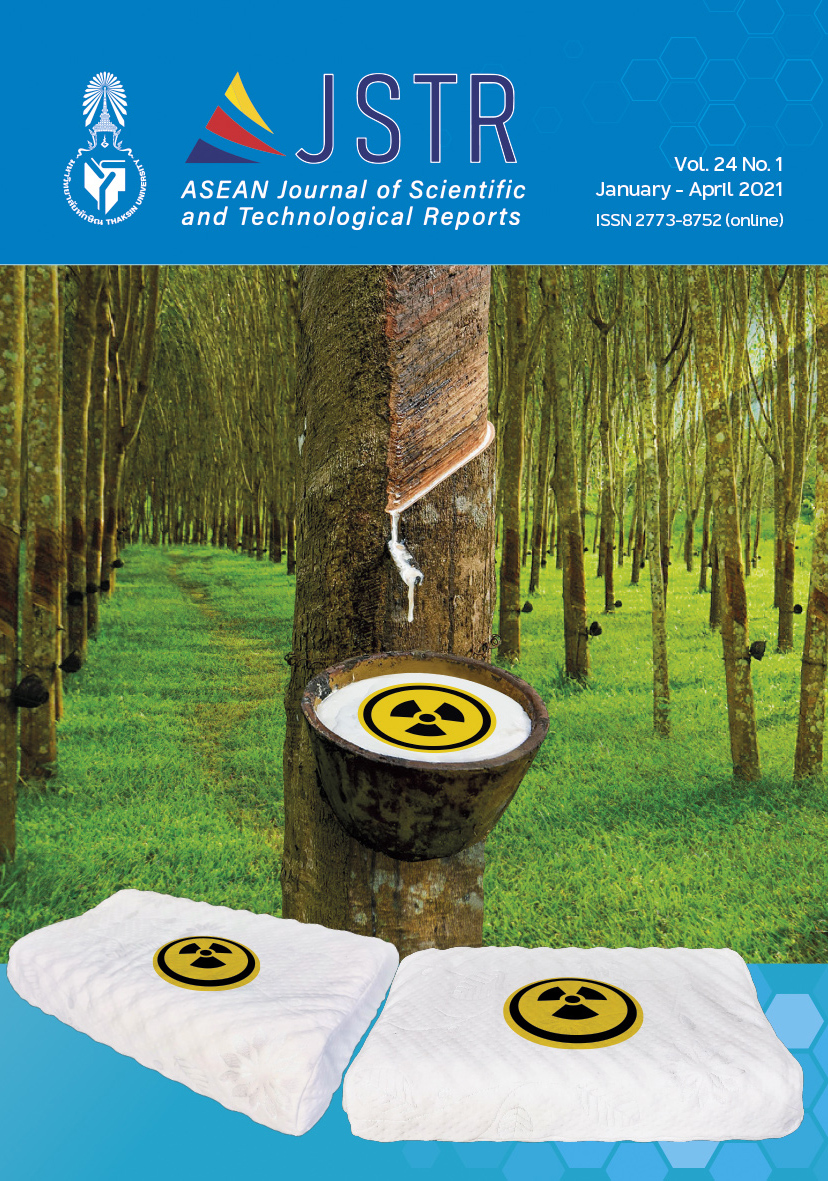Determination of Longkong (Lansium domesticum Corr.) by Microwave Sensor Technique
Main Article Content
Abstract
The purpose of this research is to determine the suitable harvest index for harvesting Longkong bunches for export to overseas or distant markets. The technique for analyzing concentration of microwave through Longkong fruit with microwave optics was used. The results from the microwave concentration analysis were compared with the ratio of total soluble solids to acid content (TSS: TA) of Longkong fruit ages of 85-120 days after anthesis. The results showed that the concentration of microwave was in the range of 0.75-0.58 mA, which the Longkong fruit have the ages of 91-103 days after anthesis and TSS: TA was between 6.13-9.86. The Longkong fruit has yellow skin, firmly attached to Longkong bunch, and a sweet taste, suitable for export to distant markets or overseas. For the concentration of microwave in the range of 0.58-0.41 mA, the TSS: TA was in the range of 9.86-13.55, in which the Longkong fruit was 103-115 days after anthesis, the Longkong fruits are very sweet, and the skin is dark yellow, tasty. It was suitable for selling near the orchardt.
Article Details

This work is licensed under a Creative Commons Attribution-NonCommercial-NoDerivatives 4.0 International License.
References
Lichanporn, I., Nanthachai, N., Tanganurat, P., Singkhum, A., & Techavuthiporn, C. (2016). Use of oxalic acid to inhibit browning on longkong fruit after harvesting. Huachiew Chalermprakiet Science and Technol Journal, 2(1), 36–44.
Sombatpraiwan, S., Tipwimol, T., & Treeaumnak, K. (2012). Postharvest changes in quality characteristics of Nam Dokmai mango (Mangifera indica L.). In The 13th TSAE National Conference. 521. April 4–5, 2012, Imperial Mae Ping Hotel. Chiang Mai: Thai Society of Agricultural Engineering.
Assavarachan, R. (2011). Drying agricltral products by microwave. Kasem Bundit Engineering Journal, 1(2), 31–42.
Timkhun, P., & Terdwongworakul, A. (2013). Non-destructive classification of durian maturity of ‘Mongthong’ cultivar by visible spectroscopy of the husk. Thai Society of Agricultural Engineering Journal, 19(1), 1–6.
Orsat, V., & Vijaya Raghavan, G.S. (2007). Microwave in postharvest applications with fresh fruits and vegetable. Fresh Produce, 1(1), 16–22.
Kaewtubtim, P., Chittrakarn, T., Bhongsuwan, T., Aiyarak, P., & Kongsaeng, S. (2007). Spectral reflectance analysis of longkong (Lansium domesticum Corr.) bunches as an indicator for optimal harvesting. Songklanakarin Journal of Science and Technology, 29(5), 1427–1438.
Taesakul, P., Imsabai, W., & Siriphanich, J. (2018). Fruit drop at the junction between the and fruit of longkong (Lansium domesticum Corr.) dose not depend on ethylene or ethylene or the induction of cell wall degrading enzymes. Postharverst Biology and Technology, 144, 77–85. DOI:10.1016/j.postharvbio.2018.05.015.
Venkatachalam, K., & Meenune, M. (2012). Changes in physiochemical quality and browning related enzyme activity of longkong fruit during for different weeks of on-tree maturation. Food Chemistry, 131(4), 1437–1442. DOI: 10.1016/j.foodchem.2011.10.022.


